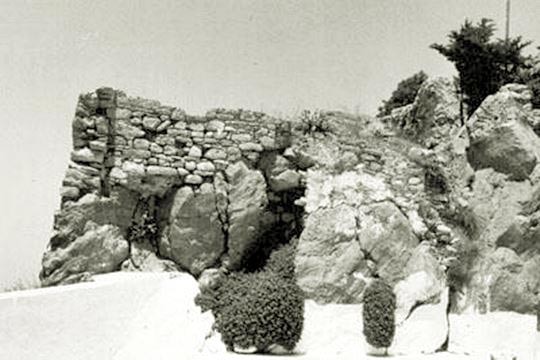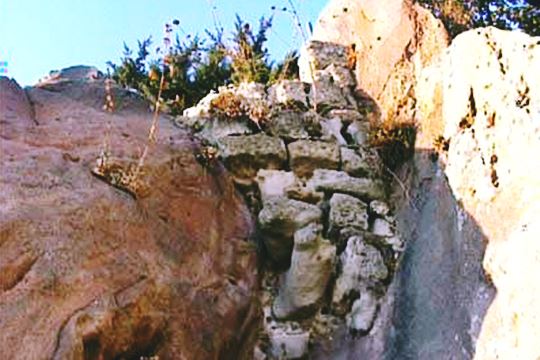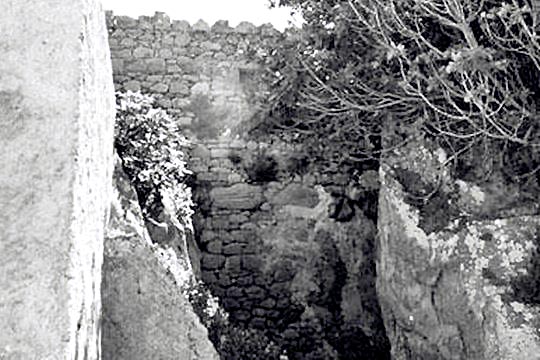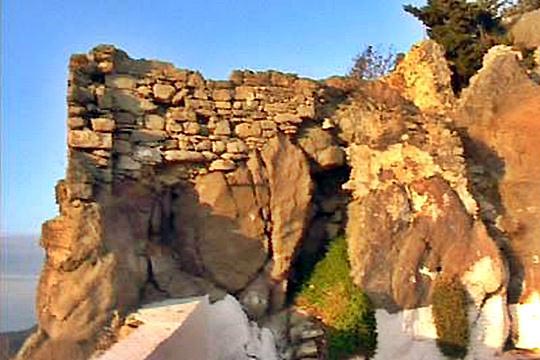Nikiá, Nisyros, Dodecanese,South Aegean
Castle of Nikia
| Location: |
| At the northwestern edge of the village of Nikiá in Nisyros island |
| Region > Prefecture: | 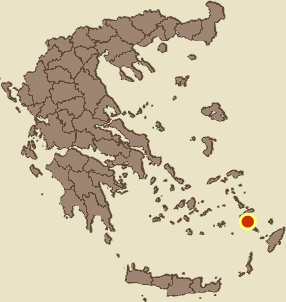 |
| South Aegean Dodecanese | |
| Municipality > Town: | |
| City of Nisyros • Nikiá | |
| Altitude: | |
| Elevation ≈ 430 m |
| Time of Construction | Origin | |
| 14th or 15th cent. | IOANNITE |
|
| Castle Type | Condition | |
| Castle Ruins |
Few Remains
|
Sparse remains of late-medieval castle on a rock at the northwestern side of the village of Nikiá, presumably built by the Knights of St. John (Hospitaller Knights). Occasionally confused with the Kástro Árgos (or Kástro stó Stávro), 2 km towards the west-southwest.
Castle Description
Text: Dr. Michael Losse – Singen (Hohentwiel), Germany (21.12.2020)General description
The village of Nikiá is located in the southeast of the island on the volcanoe’s caldera, at an altitude of about 430 m. At the southwestern edge of the village, at its highest point, rises the small, steep rocky dome with the sparse remains of the small castle, which is known among older inhabitants of the village as “Kástro”, while it is no longer known to younger people in the village.
From the lookout point into the volcano (signposted from the parking area), the “forecourt” of the castle rock, remains of mortar masonry are visible, especially on the east side of the rock. These are remnants of the medieval enceinte. The small-scale square masonry indicates the construction in the time of the Knights of St. John.
It remains unclear whether the castle was confined to the rock or whether the forecourt was included into an outer enceinte. Since it is now covered with slabs and is bordered in the north and east by houses (whose building material was partly taken from the ruins of the castle), there is no knowledge about the possible development of this site.
There are visual connections from Nikiá castle to the medieval castles of Parlettía, Emporeiós and Árgos (Kástro stó Stávro) at Nísyros. The islands of Tílos (to the SE), Pacheía (to the SW) and Kandelioússa (W) can also be seen from here.
Access (route / entrance)
By bus from Mandráki.
By car: Parking area in front of the village; follow the signposted way from there to the lookout point into the volcano, which is next to the castle.
Free access, but the steep castle rock is not accessible because of a lack of ascent.
History of the castle/tower
The island of Nísyros is located 16 km south of the island of Kós and about 17 km southwest of the Turkish peninsula of Knídos. In 1316, the Chivalric Order of the Knights St John awarded the island as a permanent fief (“in perpetuo feudo”) to Giovanni and Buonavita Assanti d‘Ischia. In 1352 there was an uprising by locals against the Assantis and in 1386 the Order took back the island under its own administration. In 1433, after the fief had changed hands several times, it passed to the Knight of the Order fra Fantino Querini, the Prior of Rome and commander of the island of Kós. He had to pay 600 “fiorini d'oro” per year and to make sure that all the castles of the island were “ben guardati, ben muniti, e riparati”.
Several attacks by Muslim corsairs and Ottoman troops took place in the 15th century, but apparently there was no direct attack on one of the Nisyrian castles. The raids in 1457 were particularly devastating, of which an entry in a manuscript kept in the library of St John’s Monastery on the island of Pátmos reports. F. W. Hasluck (1910-11) wrote, the island “does not appear to have remained deserted long, since we hear of a population in 1485”. In 1471, the island’s population was evacuated to Rhodes when new attacks were feared, but the people soon returned.
There were three castles on the island according to Niccolo de Martoni, a notary from Campania who wrote his memoirs recounting his journey to Jerusalem (1394-95) and visited Nísyros in 1394 (cf. Relation de pèlerinage à Jérusalem di Nicolas da Martoni, notaire italien [1394-1395], edited by Léon Le Grand, in: Revue de Orient Latin III, 1895).
Cristoforo Buondelmonti (1380-1430), a Florentine monk, was the first European to write a comprehensive description of the Greek islands. In 1406 he settled on Rhodes and in the following years he visited many Aegean islands. In 1420 he finished the first manuscript edition of his work “Liber Insularum Archipelagi”, a book which was never printed, but there are some handwritten copies (cf. Émile Legrand: Description des Iles de l'Archipel par Christophe Buondelmonti version grecque par un anonyme publiée d’apres le manuscrit du Sérail […], Paris 1897). Buondelmonti reported five “oppida” on Nísyros: “quinque videntur oppida, quorum duo principaliora apparent, Mandrachi et Palaeocastro; et Pandenichi, Nicea et Argos sunt in circuitu” (cf. Ludwig Ross 1843, p. 75); Dawkins/Wace (1905-06, p. 170) called those places “castles”.
Economakis (2001, p. 82) mentioned the castle at Nikía, beside that one of Emboreíos, as one of the Nisyrian “fortified mountain villages”, which were “already established” during the Knights Hospitallers’ rule (for the castle at Nikiá see also note 198, ibid.).
It seems, the Kástro of Nikiá was built during the Knights of St. John‘s (Hospitaller Knights’) rule, maybe to serve as a refuge for the local population, but also as a lookout-post. Details and exact dates are not known.
Other Info
SourcesEconomakis, Richard [text]/De Vries, Cornelis [photos]: Nisyros. History and Architecture of an Aegean Island. Athens 2001, pp. 82-83.
Hasluck, F. W.: Depopulation in the Aegean Islands and the Turkish Conquest. In: The Annual of the British School at Athens (BSA) No. XVII, 1910-11, pp. 151-181.
Losse, Michael: Johanniter-Ordensburgen auf den Dodekanes-Inseln Kálymnos und Nísyros/Griechenland […]. In: Burgen und Schlösser 3, 1996, pp. 112-126 [in parts no longer up-to-date, update will take place in 2021].
Losse, Michael: Die Burgen und Festungen des Johanniter-Ritterordens auf Rhódos und in der Ägäis (Griechenland) 1307-1522. (Publisher: Nünnerich-Asmus Verlag) Mainz 2017.
Ross, Ludwig: Reisen auf den griechischen Inseln Ägäischen Meeres. Zweiter Band. Enthaltend Andros, Syros, Mykonos, Amorgos, Astypaläa, Nisyros, Knidos, Kos, Kalymnos, Telendos, Leros, Patmos, Samos, Ikaros, DeIos, Rhenäa, Gyaros, Belbina. Stuttgart und Tübingen 1843.
Spiteri, Stephen C.: Fortresses of the Cross. Hospitaller Military Architecture (1136-1798). Valletta (Malta) 1994.
| First entry in Kastrologos: | December 2020 |
Sources
- Text and photographs Νο.1(2008) by Dr. Michael Losse
- Photos 2,3,4,5 are from the website ΟΔΥΣΣΕΥΣ - Greek Ministry of Culture Κάστρο Άργους, which by mistake were placed in the castle of Argos in Nisyros.
|
|
| Access |
|---|
| Approach to the monument: |
| By bus from Mandráki. By car: Parking area in front of the village; follow the signposted way from there to the lookout point into the volcano, which is next to the castle. |
| Entrance: |
| Free access, but the steep castle rock is not accessible because of a lack of ascent. |



